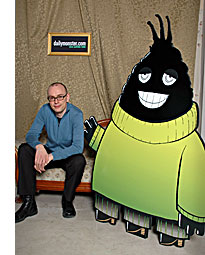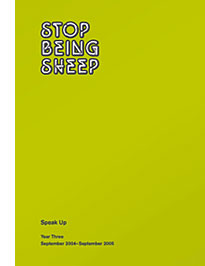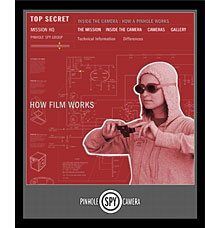I’m a big believer in design firms taking on self-directed projects. They are a wonderful outlet and afford designers the opportunity to “own” something, which is rather rare in most client-driven projects. In fact, I presented a Thinkshop on this topic at the Y Conference in lovely San Diego last spring.
In this and a couple of posts to come I’ll talk about the reasons for some of smashLAB‘s self-directed work, as well as some observations that might be of use if you choose to do the same. In this one, however, I’d like to look at a few people I admire and why they initiate their own creative exercises. I contacted these designers to ask a little about their experiences; additionally, I reflect on a few groups who have been doing similar things.
![]() Stefan Bucher
Stefan Bucher
 I find Stefan‘s activities quite delightful. He’s a much different kind of designer than I, and sometimes it just seems like he just has far more fun than the rest of us. You’re likely well aware of his projects like the Daily Monster videoblog, in which he’d post the creation of a new monster every day. The project later resulted in a book, which I sadly still don’t own (but will someday).
I find Stefan‘s activities quite delightful. He’s a much different kind of designer than I, and sometimes it just seems like he just has far more fun than the rest of us. You’re likely well aware of his projects like the Daily Monster videoblog, in which he’d post the creation of a new monster every day. The project later resulted in a book, which I sadly still don’t own (but will someday).
When I asked why he takes on these projects, he explained that, “when I have ideas they haunt me”, which is a sentiment that I think most all designers and artists will appreciate. Over the years he has learned a few things that I think we’d all be wise to remember in our efforts. He notes:
1. I can always rely on the work to lead me to good
2. I can always work a little harder than I thought
3. The key might be under the next stone
Stefan has found these projects beneficial in forming the bedrock of his practice and also for R&D. Additionally; he notes that all of his commercial clients have developed from private passions. When asked what he suggests for the rest of us taking on our own projects, he advises preparing to “say good-bye to your tan” and to expect to “get hassled for working all night and getting up late”.
Armin Vit
 Most all of us are familiar with Armin’s work on UnderConsideration, which he calls “a long, gestating series of self-directed projects”. He started with SpeakUp in 2002 and it later grew into two other blogs and one wiki. He has also worked on the self-funded Stop Being Sheep booklets, created contests for t-shirts and posters, formed makeshift lectures, and more.
Most all of us are familiar with Armin’s work on UnderConsideration, which he calls “a long, gestating series of self-directed projects”. He started with SpeakUp in 2002 and it later grew into two other blogs and one wiki. He has also worked on the self-funded Stop Being Sheep booklets, created contests for t-shirts and posters, formed makeshift lectures, and more.
He takes on these projects for many of the reasons that you’d expect. Armin explains that with these projects he can do as he pleases, and he enjoys being in charge. He believes it is healthy to have “an alternative to your day-to-day work that is (in theory) client-directed”, noting that he uses “both scenarios as a way to test things out and one informs the other.”
Through this work he has learned that it’s difficult to self-direct, underscoring the importance of having “some sort of guiding voice placing limits and/or challenges.” Through this he has made a deliberate effort to establish goals, schedules, budgets, expectations and learn when to say “this is wrong” to himself.
For all of the challenges noted in directing oneself, Armin feels that his self-directed efforts have been life-changing, allowing him to create a voice for himself in the design community. At the end of our Q&A he left me with two (rather focused) observations for the rest of us: “Money. Don’t lose it.” and “Money. Try to make some of it.” (I hear that.)
Wil Arndt
 Two blocks south of us lives our good friend Wil Arndt of mod7. More recently his firm has shifted away from self-directed work; nevertheless, he still believes that his past efforts have been pivotal in his success.
Two blocks south of us lives our good friend Wil Arndt of mod7. More recently his firm has shifted away from self-directed work; nevertheless, he still believes that his past efforts have been pivotal in his success.
Perhaps most notably mod7 created with Pinholespy.com in 2000, a pinhole camera educational site that attracted a great deal of attention for their firm. Between 2000 and 2001 they worked on Dots Magazine, the first arts and culture magazine specifically designed for the mobile platform and devices. Meanwhile, they started mod7 Daily Headlines, a 2 year project that involved visual design “blogging”, interpreting news headlines. They also toyed with digital poetry and peer-to-Peer 3D Chess in the 2000s.
Wil feels that the reason he’s taken on these projects was largely because they had to. He believes that they represent “what we do” and “why we do it”. Through these efforts his operation has achieved visibility, proved capability, built “team-ness”, and gained experience. He notes that for young companies such efforts are largely about “putting in your dues.” That said, he explains that they, “won’t do the self-directed work anymore, unless it can lead directly, or indirectly, to paying the bills.”
Our email discussion wrapped with a few pearls of wisdom regarding self-directed work. He notes: “And if it’s not completely awesome, pull the plug and bury it sooner rather than later. Nothing is worse than spending time and money trying to resuscitate a dead idea that will make you look mediocre or stupid. And flushing your own money down the toilet even though you know it’s a doorstop makes it that much worse. There is a difference between simply not following through and recognizing the wisdom of your errors.”
Lots of people have done (or are doing) it
 Most all of us are familiar with Tibor Kalman; nevertheless, I think it’s interesting to reconsider just how heavily he relied upon self-directed projects as a conceptual playing-field. Think of the the visual puns including the umbrellas with bright skies within, the lead paperweights and all of those playfully surreal watches; meanwhile, his firm gained a great deal of attention for their holiday gifts that had social intention, urging people to consider those less fortunate.
Most all of us are familiar with Tibor Kalman; nevertheless, I think it’s interesting to reconsider just how heavily he relied upon self-directed projects as a conceptual playing-field. Think of the the visual puns including the umbrellas with bright skies within, the lead paperweights and all of those playfully surreal watches; meanwhile, his firm gained a great deal of attention for their holiday gifts that had social intention, urging people to consider those less fortunate.
The people at Coudal are always capturing our attention with their blog, The Deck advertising network, their Obama t-shirts, and numerous other exercises. And of course, Jason Fried and the folks at 37signals self-directed projects have become the end-goal, allowing them to transition from professional services to “shipping” their own products. Their Basecamp software has received countless accolades and has spawned an entire software suite from their operation. They’ve also authored “Getting Real“, which I believe is a must read for everyone who works in this industry.
Next time…
And that concludes Part 1. Next time I’ll get a little more personal, and talk about some of the self-directed projects that we’ve take on to date at smashLAB.
Wednesday, September 17th, 2008

Comments & Trackbacks